Cultivation of deer-horned sumac
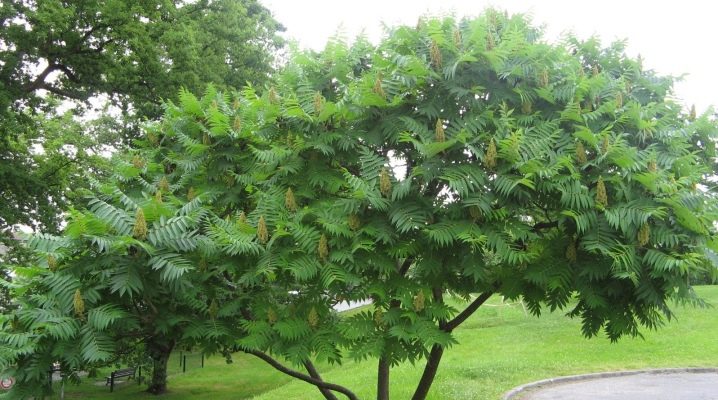
Deer-horned sumac is a very beautiful and absolutely unpretentious plant that can become a godsend for any site. After planting, carried out with seeds, cuttings or root shoots, the plant requires little or no maintenance.
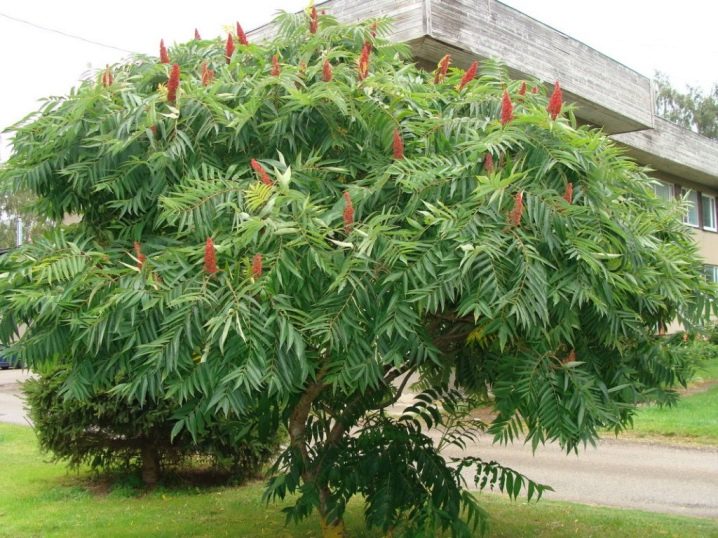
Description
Deer-horned sumac is also known as sumac fluffy or vinegar tree. Its Latin name is Rhus Typhina. "Deer antlers" in the name appeared because of some similarity with the branches of the plant. This representative of the Sumakhov family grows naturally in the eastern regions of North America. A deciduous tree that prefers rocky slopes and calm, sunny areas, reaches a height of 3 to 10 meters.
It is interesting that in youth it stretches upward, and then begins to grow in breadth.
The length of large and slightly tapered sheets, made up of 9-30 small fragments, ranges from 25 to 55 centimeters, which allows the branches to form a large diameter around them. In autumn, they take on a bright red color.
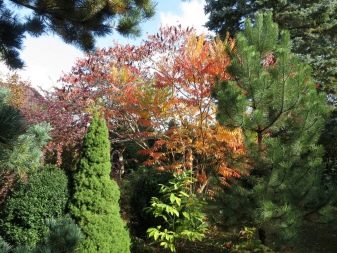
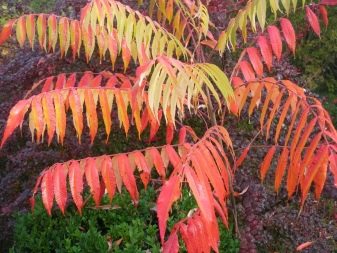
Young shoots, as well as leaf petioles of the plant, are covered with velvety villi. The flowering of a culture resembling a small palm tree is accompanied by the appearance of lush panicles, collected from male yellow-green flowers or female saturated burgundy hue. The length of these cone-shaped inflorescences is 10-20 centimeters, and the diameter does not go beyond 4-6 centimeters.
Sumac blooms no earlier than the fourth year after planting, exuding a refreshing vinegar aroma - the source of its second name. Deerhorn fruits are miniature red drupes, collected in panicles. They ripen, as a rule, at the end of autumn in an amount of up to 5000 pieces.
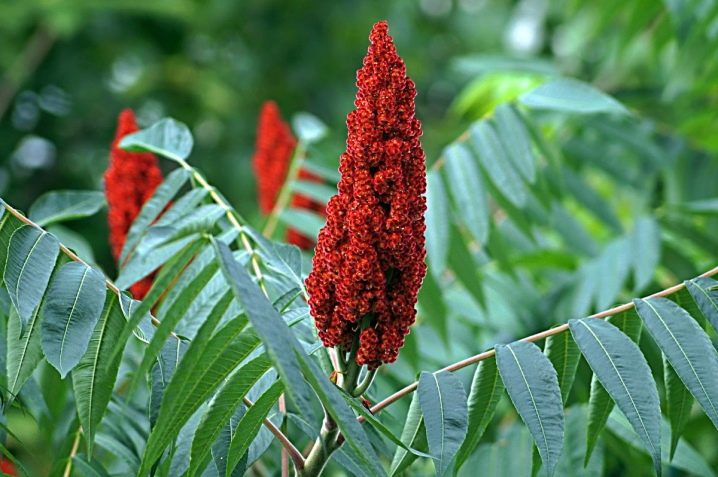
The vinegar tree develops very quickly, especially when planted at a young age. During the first year of life, a small stalk can transform into a tree that is almost one meter long. In a young state, the deer-horned sumac has fluffy, almost soft shoots that are tactilely pleasant and look extremely attractive.
Given the annual appearance of beautiful burgundy inflorescences, it is not surprising why culture has recently been so actively used in landscape design. The advantage is that the plant manages to form both a tree and a shrub.
Vinegar tree maintenance is minimal. Under favorable conditions, it can be limited exclusively to watering.
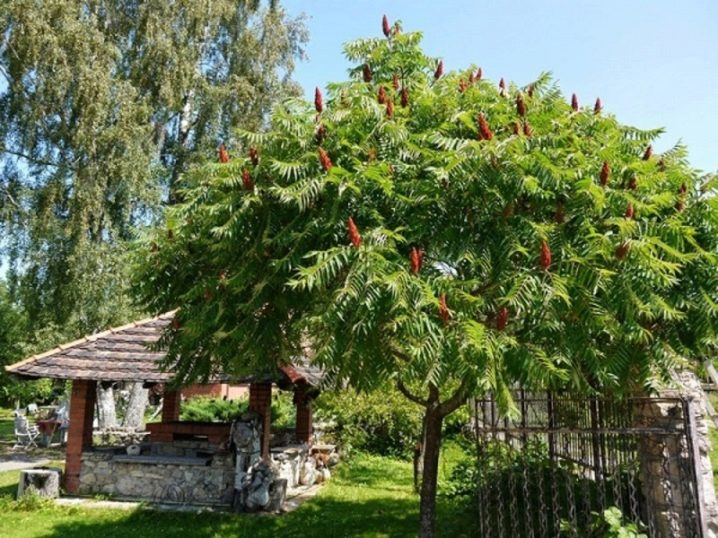
However, it should be borne in mind that the long roots of the plant lie close to the surface. As a result, shoots appear from them, pulling nutrients from the main tree. Sumac seeds are an excellent alternative to lemon and citric acid, and therefore they are used to make lemonades and are used as a seasoning. Other parts of the deer-horned sumach are poisonous, and therefore interact with them is allowed only with gloves.
The way the tree hibernates can also be a problem: it happens that the ends of the branches freeze slightly. However, usually the vinegar tree can withstand cold snaps up to -30 degrees, and the freezing of parts of the shoots does not lead to any consequences: the plant quickly recovers due to the awakening of the lateral buds. The life cycle of a culture is maximum 20 years.
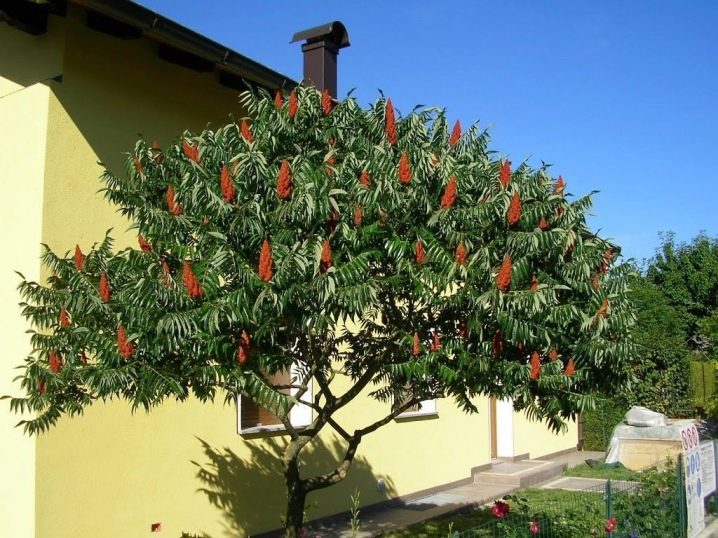
Growing
Even a novice gardener will be able to grow deer-horned sumac on the site.
Location
For the vinegar tree on the site, you must choose the most illuminated place. The site should be reasonably spacious, free and open to the sun. Partial shade and completely shaded places are not suitable for culture. You can not plant sumac near buildings: it is more correct to choose the middle of the site.
Such a solution, by the way, will make it easier to get rid of root growth. However, not every gardener seeks to eliminate it: there is a point of view that single-stemmed trees live less than those surrounded by undergrowth.
The seedling of the plant does not perceive drafts well, therefore, for young trees, it will be necessary to select areas protected from the winds.
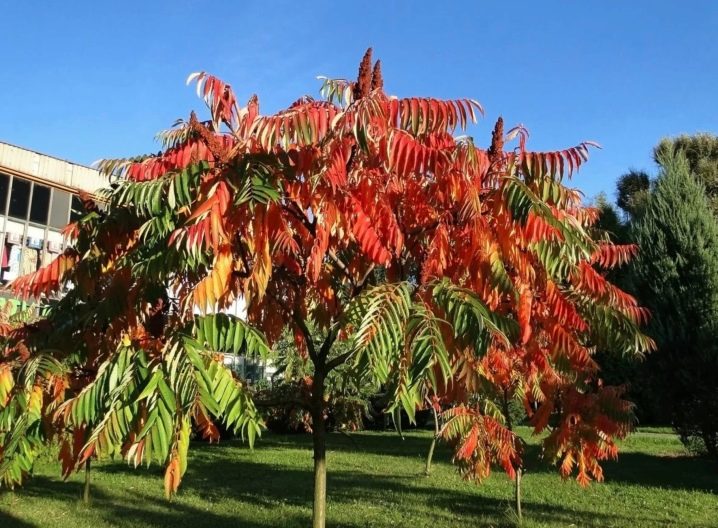
The soil
Despite the fact that in nature, sumac is often found on stony and even calcareous areas, as well as sandy loams, fertile, loose, moderately moist soil is more suitable for its independent cultivation. Ideally, we are talking about sandy, sandy-rocky or sandy-clayey soil. A swampy area or one that is characterized by a close occurrence of groundwater is categorically not suitable for a vinegar tree. The plant is able to withstand slight soil salinity.
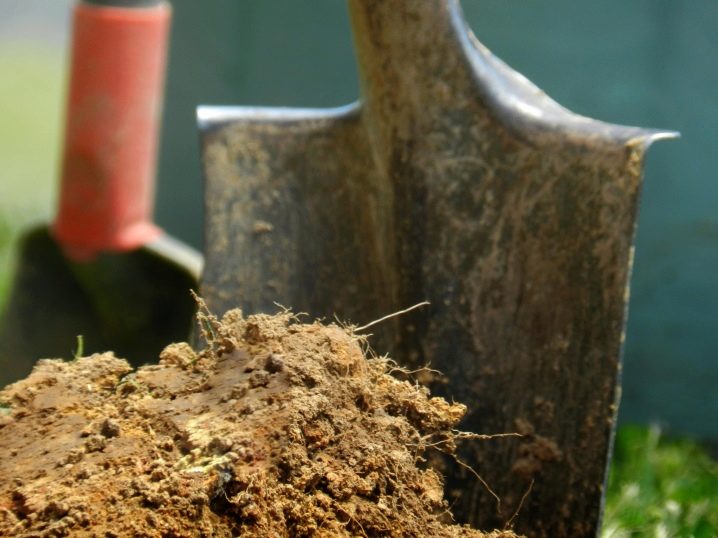
Landing
The easiest way is to plant an offshoot of the root system of a culture. For this purpose, the most developed, tall and healthy seedling is removed from the ground using a well-sharpened tool. Since the shoots feeding on the roots of the mother tree do not have their own root system, the separation will have to be carried out in such a way as to obtain the maximum cut. If the resulting sumac is to be planted after some time, then its bottom will need to be carefully covered with wet sawdust or moistened woolen rags, and then packed in polyethylene. If everything is done correctly, then it will be possible to save the plant for a week.
The shoots are planted in a hole with sides and a depth of 50 centimeters. It is filled with half a bucket of humus, which is mixed with the soil, and then irrigated with a bucket of water. As soon as all the moisture is absorbed into the soil, it will be possible to place sumy in the hole. It is important to make sure that it does not go deeper than before. The contents of the hole are covered with earth, and half of the bucket of water is poured out under the future trunk circle.
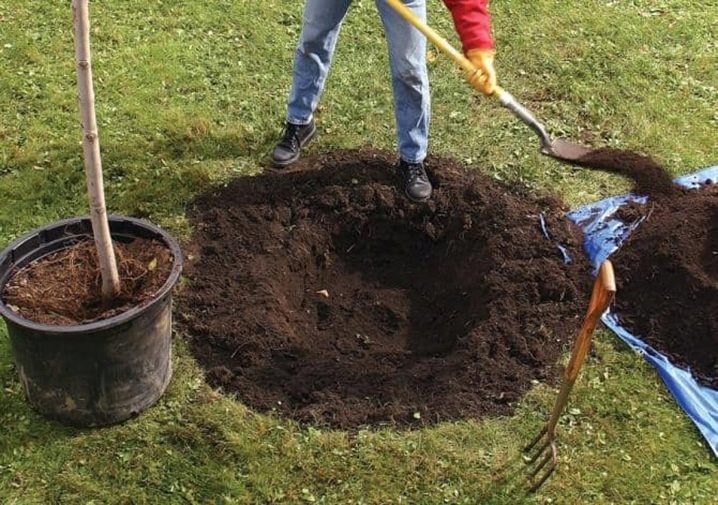
Planting vinegar seed is even easier. First of all, the bone rubs against a whetstone or is otherwise mechanically damaged, so that the sprout can then hatch. The dug planting hole is filled with fertilizers and a layer of soil. The planting material deepens by 15-20 centimeters and is watered with settled water.
Since sumac takes a long time to germinate, sprouts are expected to appear no earlier than 20-30 days.
It should be mentioned that fresh seeds are sown in open ground in spring, and pre-stratified seeds in autumn. The latter includes a 50-minute stay in a sulfuric acid concentrate, as well as scalding with boiling water.

When using a purchased seedling, it is better to choose one that has already reached the age of three and has a closed root system. It is recommended to give preference to domestic specimens adapted to the local climate. To fill the hole, a mixture of leaf earth, coarse sand and compost is prepared, used in a ratio of 1: 2: 1. The procedure is carried out in the fall.
The tree is located in a hole so that its root collar deepens by 5 centimeters. A gap of approximately 2-4 meters is maintained between individual specimens. The planted seedling needs three days of abundant irrigation. A day after planting, a mulching layer about 5 centimeters thick from wood chips, peat or sawdust is organized.
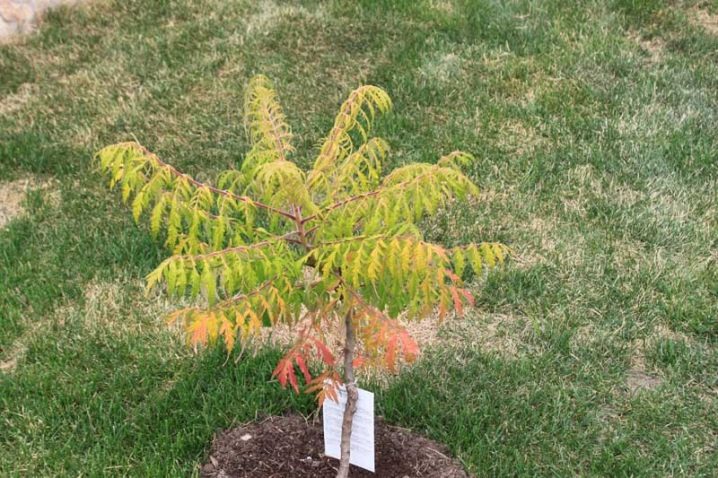
Watering
Reindeer sumac should be irrigated moderately: not too much and not too often. Young trees generally need moisture only on dry hot days. On average, the procedure is carried out about once a week so that the soil remains moist, but not flooded. The presence of a mulching layer is important. No less important is the loosening procedure, carried out with great care so as not to damage the roots.
Sumac can withstand a short drought without any problems.
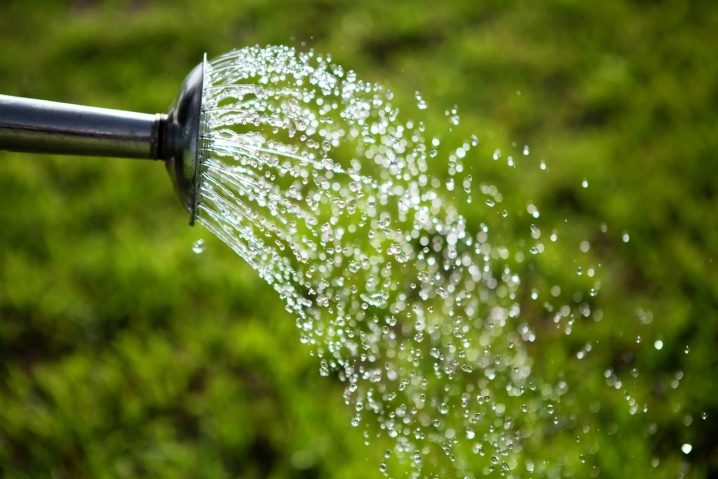
Top dressing
The vinegar tree can develop without any fertilizers at all, but once a year it can be fed with mineral compounds. It is better to avoid nitrogen-containing mixtures, as they can slow down the growth of the tree, or even destroy it.
An important component of caring for fluffy sumac is the timely removal of broken or dried branches. You don't have to trim the crown, because it is its free development that is the key to the beauty of the tree. In the spring, those shoots that are frozen must be removed. A rapidly growing root system and weeds will also need to be controlled. To prevent young shoots from freezing in frost, you should think about organizing a thick layer of mulch for the winter, as well as covering with spunbond or spruce branches.

Reproduction
It is customary to propagate deer-horned sumac by seeds, the production of which is possible only in the presence of plants of both sexes. The material is thoroughly cleaned of pulp, filled with hot water and left to infuse for 24 hours. It is believed that if the shell is damaged, the grains will germinate better.
Sowing can be carried out in spring or autumn, with the second option being considered more preferable.
Suitable for culture propagation and vegetative propagation. In this case, either shoots that appear on the roots are used, or green cuttings are cut off in the summer months. Green shoots, however, root very poorly, and therefore this method is practically not used. The planting of root shoots was mentioned above.
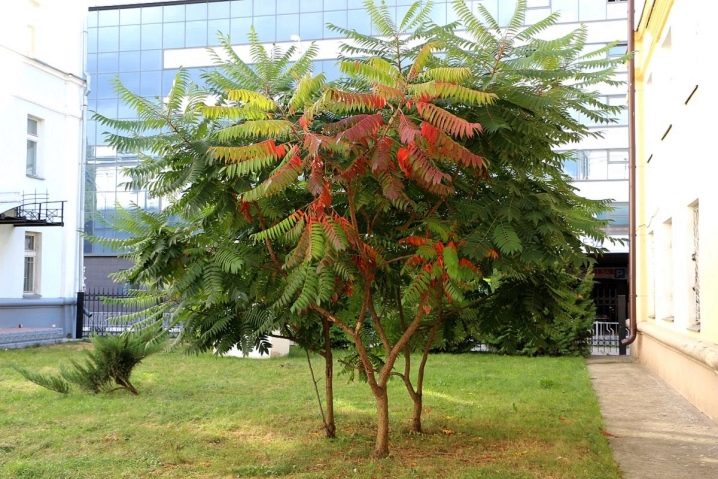
Diseases and pests
Reindeer sumac practically does not get sick and is not interested in pests. However, the accumulation of water in the soil can lead to rot of the root system and provoke the development of fungal diseases. The plant does not begin to bloom immediately, so you should not worry about the lack of flowers and fruits in young plants. If the tree dries up, and its leaves are all covered with a spreading bloom, capturing both the branches and the trunk, then fungi, for example, provoking powdery mildew, may be to blame.
In this case, all affected parts of the tree must be removed and treated with suitable chemicals. Prevention of fungal diseases is considered to be regular weeding, periodic inspection of branches, moderate watering and respecting the gaps between trees.

Examples in landscape design
A vinegar tree in landscape design requires neighbors that will not overshadow its original beauty, but, on the contrary, will act as a background or create the required contrasts. Sumac will fit well into a composition of conifers with a horizontal crown or blue needles, it will look great in a frame of evergreen beauties.
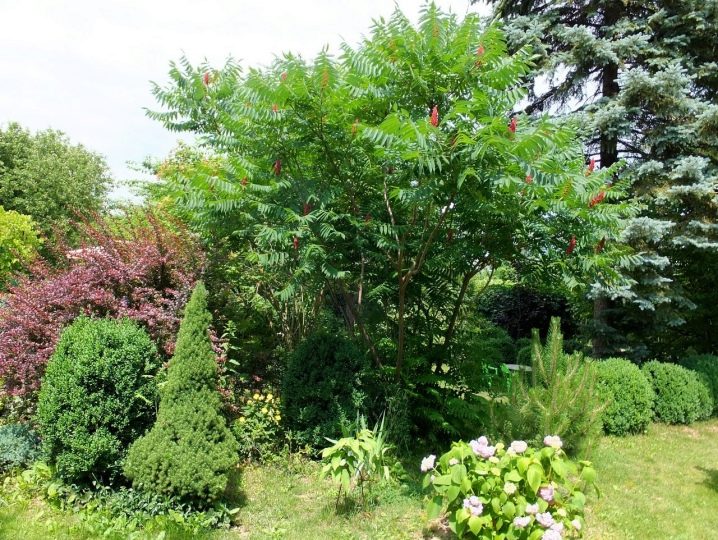
You can make the tree the center of the composition by complementing it with undersized shrubs. A variant with an alpine slide is also possible, especially since the deer horn will be able not only to place the necessary accents, but also to strengthen the slope. The fluffy tree looks quite impressive in a single planting on an open flat area, and it also makes impressive hedges.
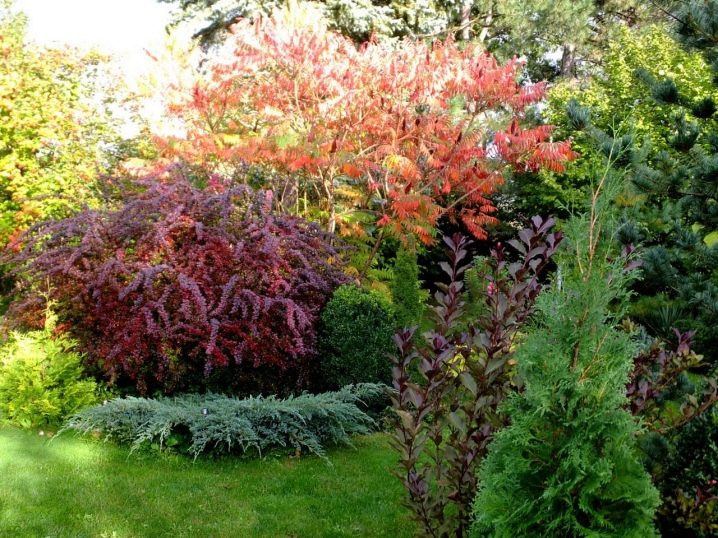



































































The comment was sent successfully.